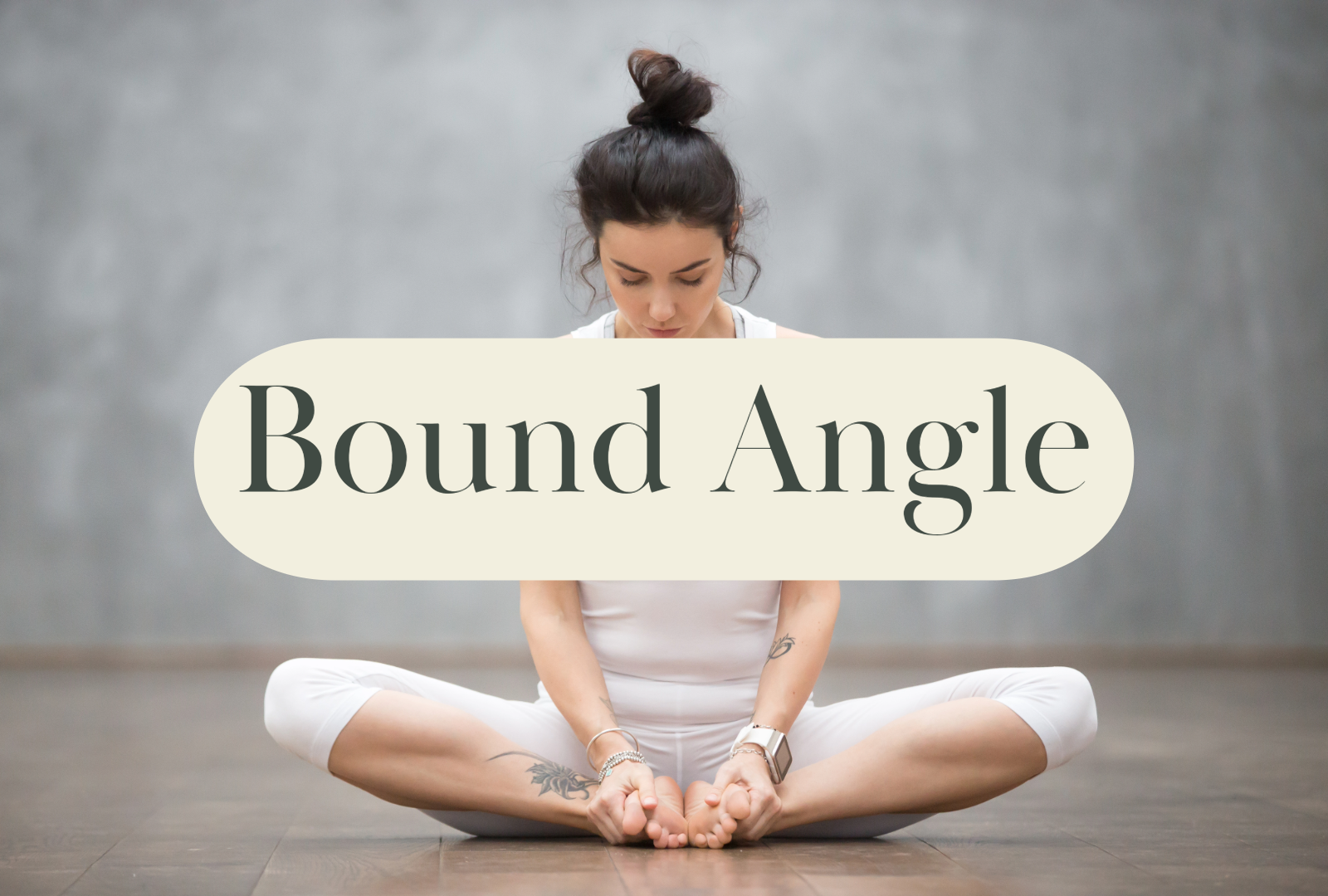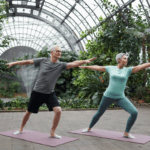Coming Soon: E-book about Kundalini Yoga - Sign up here to be among the first to get it!
Sanskrit: Baddha Konasana
Type: sitting pose, hand-to-feet
Chakra Involved: Sacral Chakra (Swadisthana Chakra), Root Chakra (Muladhara Chakra)

In the mosaic of yoga practices, each pose (or ‘asana’) holds a unique place, resonating with the history, philosophy, and physical intricacies of yoga. Today, we turn our gaze towards a gem in this mosaic: the Bound Angle Pose, or Baddha Konasana (BAH-dah koh-NAH-sah-nah) – a foundational pose that mirrors the openness and groundedness that yoga embodies. This article is crafted for the curious minds of yoga teachers and practitioners eager to explore the depths of Baddha Konasana, enriching their practice and teaching repertoire.
The Historical Weave of Baddha Konasana
Tracing the roots of Baddha Konasana takes us back to the ancient texts of yoga, where it is said to embody the essence of a butterfly – a symbol of transformation. This pose, with its historical ties to meditation and pranayama (breath control) practices, offers a bridge to the past, allowing practitioners to connect with yoga’s profound spiritual lineage.
The Anatomy and Benefits Unfolded
Baddha Konasana gently stretches the inner thighs, groins, and knees, promoting flexibility in areas often stiffened by sedentary lifestyles. It’s not just about flexibility; this pose also encourages a healthy pelvic floor, vital for core stability and reproductive health. The forward bend, inherent in deeper variations, massages the abdominal organs, enhancing digestive efficiency and detoxification.
Let’s not overlook the pose’s calming effect on the mind and nervous system, making it a sanctuary for those seeking tranquility in today’s fast-paced world.
Who Should Approach with Caution?
While Baddha Konasana is generally safe, individuals with knee or groin injuries should proceed with caution or seek modifications. Always listen to your body’s wisdom – it’s your most truthful guide.
A Step-by-Step Journey into Baddha Konasana
- Finding Your Seat: Begin seated with your legs extended forward. Exhale, bending your knees, and pull your heels toward your pelvis. Drop your knees out to the sides, pressing the soles of your feet together.
- Embracing Your Bound Angle: Grasp your big toes or clasp your hands around your feet. Ensure your pelvis is in a neutral position, grounding through the sit bones.
- The Heart Lifts: Inhale, elongating your spine, lifting your chest like the proud petals of a lotus reaching for the sunlight. Maintain the length of your spine, and avoid collapsing forward.
- Deepening with Breath: If your body permits, exhale and hinge forward from your hips, leading with your heart. This is where the pose transforms from a mere physical posture to a profound blend of mind, body, and spirit.
- Being Present: Hold for 1-5 minutes, focusing on deep, steady breaths. With each inhale, lengthen; with each exhale, deepen your fold – only to the extent that feels right.
- The Release: To exit, inhale and lift your torso upright. Exhale, extending your legs forward to relax.
Variations & Modifications of Baddha Konasana
In the practice of yoga, adaptation, and modification are not just allowances; they are celebrations of individuality and the body’s unique needs. Baddha Konasana offers a fertile ground for exploration, providing various modifications and variations that can enhance the experience for practitioners at all levels. Let’s delve deeper into some of these options, ensuring a more inclusive and personalized practice.
For Beginners or Those with Tight Hips:
- Elevated Seating: Placing a folded blanket or a bolster under the sit bones can significantly reduce strain on the hips and groins, making it easier to maintain a straight spine. This slight elevation helps in tilting the pelvis forward, encouraging a more natural and comfortable alignment.
- Wall Support: Sitting with your back against a wall can help maintain an upright spine, especially beneficial for beginners who are working on their posture and flexibility.
For Those Seeking Gentle Support:
- Supported Knees: For individuals experiencing discomfort in the knees or hips, placing blocks, cushions, or folded blankets under each knee can offer support, reducing the intensity of the stretch in the inner thighs and allowing the muscles to relax more deeply into the pose without strain.
- Hand Positioning: Instead of grasping the feet or toes, place the hands on the floor behind you, fingertips pointing away. This less intense variation supports the back and allows for a gentle opening in the hips and chest.
To Deepen the Pose:
- Forward Bend: For those who wish to explore a deeper stretch, incorporating a forward bend can intensify the pose. From the upright position, ensure the spine is long, and then hinge at the hips to fold forward. Leading with the heart rather than the head encourages a more profound and safe stretch. Use the elbows to gently press the thighs closer to the floor, deepening the hip opening.
- Yoga Strap: A strap can be used to maintain the feet’s position while allowing the hands to rest comfortably on the floor, reducing strain on the arms and shoulders. Loop the strap around the feet and hold it with both hands for a gentle pull forward, keeping the spine elongated.
For Restorative Practice:
- Bolster Under the Torso: In a more restorative variation, place a bolster or a couple of stacked blankets lengthwise in front of you. As you fold forward, let your torso rest on the support, allowing for a gentle stretch with the aid of gravity. This variation is excellent for a deeply relaxing and restorative practice, suitable for all levels.
For Advanced Practitioners:
- Bound Variation: More experienced yogis might explore a bound variation of Baddha Konasana, where one reaches around the back to clasp the hands or even catch the toes. This requires significant flexibility in the shoulders and hips but can offer a deep stretch and a unique challenge.
Incorporating Props for Enhanced Accessibility
Props are not just aids but essential tools that make yoga inclusive and accessible. Encouraging the use of props can transform a practice, opening up a world of benefits to those who might otherwise feel excluded from certain poses.
- Chairs for Support: For individuals with severe hip or knee issues, performing Baddha Konasana while seated in a chair can offer a modified version of the pose. Place the feet together beneath the seat, allowing the knees to drop to the sides. This variation maintains the essence of the pose while significantly reducing the strain on the lower body.
Embracing Individual Paths
Each variation and modification of Baddha Konasana invites us to meet our bodies where they are, embracing the journey with compassion and mindfulness. As teachers and practitioners, cultivating an attitude of exploration and acceptance towards these adaptations not only deepens our practice but also enriches our understanding of yoga’s inclusive spirit.
Let these variations be a guide, not just to achieving a pose, but to understanding the unique stories our bodies tell. In the practice of Baddha Konasana, as in all yoga, it’s the journey that matters, not just the destination.
Teacher’s Tips: Cultivating Insight and Compassion
- Encourage Exploration: Invite students to explore the edge of their comfort zone without breaching it. It’s about finding the balance between effort and ease.
- Highlight the Breath: Use breath as a tool to deepen the pose, guiding students to breathe into tight spaces, and using exhalation to gently deepen the fold.
- Personalize the Practice: Recognize that everybody is unique. Offer modifications and props to accommodate different needs, making the pose accessible to all.
- Foster Mindfulness: Encourage students to stay present, observing the sensations and emotions that arise, using the pose as a gateway to inner tranquility.
Wrapping Up: The Journey Continues
Baddha Konasana, with its rich tapestry of benefits, history, and spiritual significance, offers a profound experience for those willing to delve deep. As yoga teachers and practitioners, embracing the full spectrum of this pose can enhance not only our practice but also our teaching, enabling us to guide others with empathy, knowledge, and insight.
Let the Bound Angle Pose be a reminder of the transformational power of yoga – a journey not just of physical postures but of continuous growth, self-discovery, and connection to the ancient wisdom that yoga bestows upon us. May your exploration of Baddha Konasana enrich your practice, teaching, and the lives of those you touch on this beautiful path of yoga. Namaste.
FAQs About Baddha Konasana
Baddha Konasana, or Bound Angle Pose, offers a multitude of benefits for the body and mind. It is primarily known for:
- Improving Flexibility: It deeply stretches the inner thighs, groins, and knees, helping improve flexibility in the hips and legs.
- Stimulating Abdominal Organs: The forward bend and pressure on the abdomen can stimulate the organs, aiding digestion and improving the functioning of the kidneys and the prostate gland.
- Enhancing Circulation: This pose enhances blood circulation throughout the body, particularly in the pelvic region, which can be beneficial for reproductive health.
- Relieving Symptoms: It can help alleviate symptoms of stress, menstruation, and menopause.
- Promoting Relaxation: The pose encourages relaxation and can help in reducing anxiety and stress when practiced with focused breathing.
The duration can vary based on the sequence and the comfort level and experience. Beginners might start with holding the pose for a few breaths and more, gradually increasing the time, always according to the particular yoga sequence. As flexibility improves it becomes more comfortable to maintain the pose. Listening to your body is key; do not overdo it.
- Starting Position: Sit with your spine straight and legs extended out in front of you.
- Bend the Knees: Bend your knees and bring your feet together, drawing your heels as close to your pelvis as you can comfortably manage.
- Flatten the Feet: Let the outer edges of your feet rest on the floor while you press your heels together.
- Open the Hips: Use your hands to open your feet like a book, which can help deepen the hip opening.
- Maintain Posture: Keep your spine long and straight. You can either stay upright or fold forward from the hips to deepen the stretch, depending on your flexibility.
- Hold and Breathe: Hold the pose while taking deep, steady breaths. Focus on relaxing into the stretch without forcing your knees down.
Butterfly Pose (another name for Baddha Konasana) can be challenging due to tightness in the hips and thighs, a common issue for many people, especially those who sit for long periods or have sedentary lifestyles. The pose demands flexibility in the groin and hip areas, which can be difficult without regular stretching or if there’s resistance due to physical limitations or past injuries.
While Baddha Konasana is generally safe, certain individuals should avoid it or practice with caution:
- Those with Knee Injuries: The pressure on the knees can aggravate existing conditions.
- Hip Issues: Individuals with significant hip problems might find the pose painful.
- Low Back Pain: If the pose causes discomfort in the lower back, it should be modified or avoided.
- Pregnant Women: They can practice the pose but should keep their feet further away from the body to avoid putting pressure on the abdomen.
In any case, consulting with a healthcare provider before starting or modifying any yoga practice is advisable, especially for those with existing health concerns.




